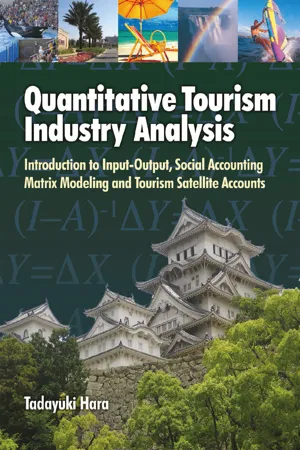
This is a test
- 288 pages
- English
- ePUB (mobile friendly)
- Available on iOS & Android
eBook - ePub
Quantitative Tourism Industry Analysis
Book details
Book preview
Table of contents
Citations
About This Book
Quantitative Tourism Industry Analysis is the first book to deal with the input-output, social accounting matrix in a way which readers from a non-economics or non-mathematical background can follow, in order to understand how useful their application would be for tourism industry analysis. It acquaints readers with useful applications of economic modelling without the unnecessary burden of higher algebra, so that they will understand concepts of the economics measurement system, Tourism Satellite Accounts (TSA) methodology.Quantitative Tourism Industry Analysis offers a new set of economic tools for tourism policy analysis, ideal for those with a non-mathematical background.
Frequently asked questions
At the moment all of our mobile-responsive ePub books are available to download via the app. Most of our PDFs are also available to download and we're working on making the final remaining ones downloadable now. Learn more here.
Both plans give you full access to the library and all of Perlego’s features. The only differences are the price and subscription period: With the annual plan you’ll save around 30% compared to 12 months on the monthly plan.
We are an online textbook subscription service, where you can get access to an entire online library for less than the price of a single book per month. With over 1 million books across 1000+ topics, we’ve got you covered! Learn more here.
Look out for the read-aloud symbol on your next book to see if you can listen to it. The read-aloud tool reads text aloud for you, highlighting the text as it is being read. You can pause it, speed it up and slow it down. Learn more here.
Yes, you can access Quantitative Tourism Industry Analysis by Tadayuki Hara in PDF and/or ePUB format, as well as other popular books in Business & Accounting. We have over one million books available in our catalogue for you to explore.
Chapter 1
Introduction to Tourism as an Industry

Tourism is a fascinating topic for study, and many excellent textbooks have been written on the subject. While tourism is often associated with fun, pleasure, and leisure, some of us study it within a historical or anthropological context. Some people are interested in sustainable coexistence of nature and humans, though humans sometimes threaten this very coexistence. Although tourism has a long history, it has seldom gained prime strategic attention as one of the viable industries for the development of a national economy. Prerequisites for tourism are peace and safety for travelers, which have not always existed throughout human history.
Agricultural production such as wheat, corn, and rice; extraction of natural resources, such as coal, timber, oil, and iron; and the trade of such tangible goods, were all very important activities to humankind, for thousands of years. After the industrial revolution, the importance of manufacturing industries increased in the nineteenth century. The basic industrial structures were formed in early twentieth century, when agriculture, mining, construction, manufacturing, transportation, trade, and financial services were considered the core industrial sectors to compete through turbulent times, which witnessed two world wars. This took place in the first half of the twentieth century, when the basic infrastructures of modern economies were formed, in terms of core industrial sectors.
It was not until the second half of the twentieth century that the numbers of travelers increased, as modern transportation systems, such as the railway, airplanes, and cars, developed, and became available to more people throughout the world. It was the jet age and the deregulation of the airline industry that made the cost of traveling relatively accessible to larger numbers of consumers. The hospitality industry, including hotels, developed a high level of efficient management styles, particularly in the US, and helped cater to large numbers of tourists. The relative importance of tourism-related industrial sectors developed, as the sales volume of these sectors was growing faster than the national economy. However, we should remember that the basic structure of modern economies had already been shaped a few decades before tourism as an industry took shape as a set of alternative economic activities of relative significance to regional and/or national economy. Tourism came a little late in order for it to be formally recognized as a powerful industrial sector. This late emergence of tourism as a viable industry at this critical moment in history will cast a long shadow. In the next section, we consider some examples of putting tourism in perspective, as an industry.
1.1 Relative position of the tourism industry in national and regional economies
1.1.1 The US tourism industry and the national economy
We begin by discussing the relative position of tourism-related sectors within the national economy. The data we use are from the US, the largest economy in the world. Before looking at the exact definition of the tourism industry, as we do in a later chapter, let us use data from hotels and from air transportation as proxies for the tourism sectors, since they have the largest tourism revenue dependency among tourism-associated industrial sectors at 80% and 76%, respectively. This means that 80% of the hotel sector’s business and 76% of the airline sector’s business derive from demands associated with tourism. We will elaborate on the issue of tourism demand dependency for each sector later in this section. Until then, we will refer to a group of industrial sectors that are associated with tourism as a ‘tourism industry complex’.
We have extracted the gross domestic product (GDP) by industry table (Tables 1-1 and 1-2) and the employment by sectors table (Tables 1-3 and 1-4). To show the significance of the tourism industry in relative terms, we will compare the tourism industry with two other traditional industries: the steel and steel-fabricating industry and the oil-petrochemical industry. This way, we will see how each sector’s share in the GDP changed and how the share of total employment in each sector changed over the period 1987–2001.
Table 1-1 US national economy at a glance – steel/steel fabricating, petrochemical complex versus tourism complex in perspective.

Source: Calculated by author using data from the Bur eau of Economic Analysis, US Commerce Department.
Table 1-2 US national economy at a glance – steel/steel fabricating, petrochemical complex versus tourism complex in perspective (percentages).

Source: Calculated by author using data from the Bureau of Economic Analysis, US Commerce Department.
Table 1-3 US national employment at a glance – steel/steel fabricating, petrochemical complex versus tourism complex in perspective.
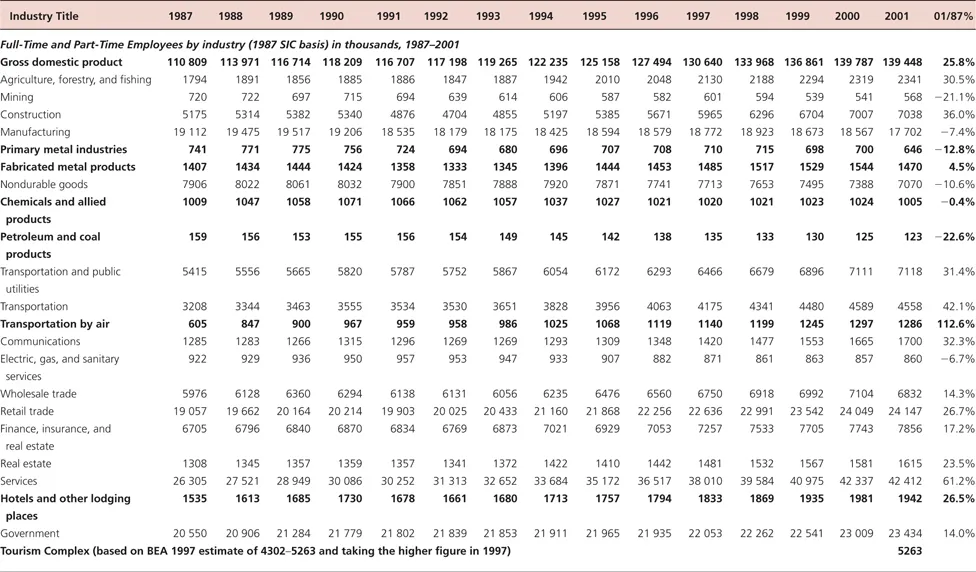
Source: Calculated by author using data from the Bureau of Economic Analysis, US Commerce Department.
Table 1-4 US national employment at a glance – steel/steel fabricating, petrochemical complex versus tourism complex in perspective (percentages).
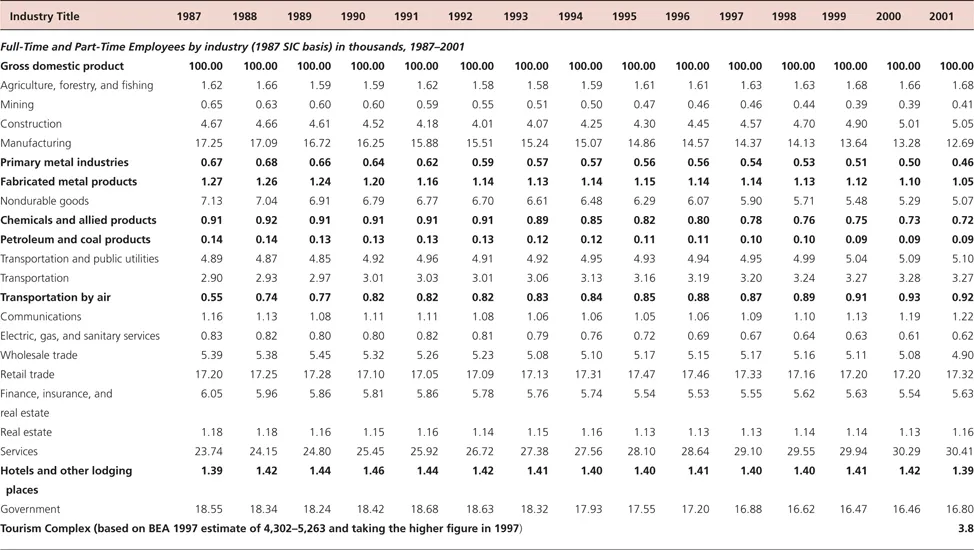
Source: Calculated by author using data from the Bureau of Economic Analysis, US Commerce Department.
Regarding the share of GDP in 1987, the steel complex had a 2.05% share, the oil-petrochemical complex had a 2.24% share, and the tourism complex had a 1.50% share. The comparable shares in 2001 were 1.45%, 2.02%, and 1.68%, respectively. As the Bureau of Economic Analysis (BEA) pointed out in its 2002 reports, however, the tourism industry complex consists of several different industries and each sector’s dependence on tourism-related revenues varies significantly. The BEA estimates that total direct sales for 2001 were of $357 billion, which would represent 3.55% of the 2001 GDP; however, the potential of the tourism complex should not be underestimated. BEA also calculated the indirect sales effect generated from the tourism industry’s economic activity, which amounted to $675 billion, or 6.69% of the GDP share (Table 1-5).
Table 1-5 Summary of relative shares of selected industrial complexes in the US gross domestic product, 1987 and 2001.
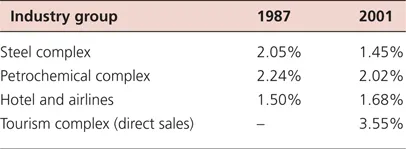
Source: Calculated by author using data from the Bureau of Economic Analysis, US Commerce Department.
Tables 1-5 and 1-6 show the trend in structural change in the US economy over the period 1987–2001, in detail. Unless we correctly introduce specific methods for compiling all tourism-related industries, such as the BEA’s tourism satellite accounts (TSAs; based on the input-output (I-O) accounting), we are likely to continue to overlook the whole picture of the tourism complex, as an industry.
Table 1-6 Summary of relative shares of selected industrial complexes in US employment, 1987 and 2001.
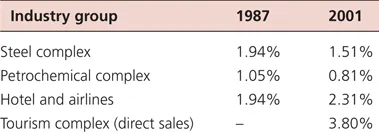
Source: Calculated by author using data from the Bureau of Economic Analysis, US Commerce Department.
From the viewpoint of policy analysis, employment aspects should be reviewed. We will compile the BEA data on employment, by industrial sector.
The employment share in the national economy decreased for both the steel complex and the petrochemical complex, while the opposite occurred with the tourism complex. Once again, employment directly generated by the tourism industry accounts for 3.8% of the national employment figures, but this figure may be underestimated, if we take the indirect effects into consideration.
Based on the above analysis, we can conclude the following:
• The share of the tourism complex in the US economy is increasing, both in terms of GDP and of employment;
• More importantly, the potential of the tourism complex as an industry may have been underestimated, due to measurement difficulties;
• For a correct evaluation of the tourism complex as an industry, the BEA advocates the global use of TSAs, which corresponds to the applied I-O framework.
In terms of share of the GDP, the tourism industry seems to have equaled the steel and petrochemical complex combined, and by surpassing the latter in terms of employment share, it has consolidated its position as one of the leading groups of industrial sectors of the US economy.
1.1.2 Composition of the US tourism industry, by sector
Although the potential of the tourism industry has often been invoked, many people remain somewhat skeptical about it. John Latham, a specialist in tourism statistics, characterizes tourism data as ‘being estimates, subject to several errors and produced with differing levels of accuracy. Sources or estimates of errors are seldom provided in tourism statistics’ reports. Tourism statistics are fraught with problems of definition, partly because tourism is a composite industry, made up of several other industries, which render its measurement more complex.’
Having stated the above, we will now consider some intriguing data gathered by the BEA, regarding the dependence of industries associated with tourism on tourism itself (Table 1-7).
Table 1-7 Total sales and tourism-related sales of tourism industries fourth-quarter 2001 at an annual rate.
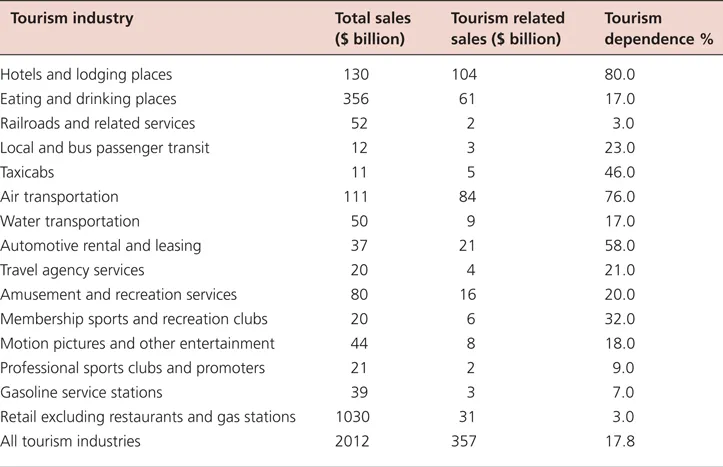
Source: Bureau of Economic Analysis (tourism dependence % column added by author).
Based on these data, not only can researchers evaluate the magnitude of the tourism industry as those engaged in, or studying any tourism-related industry, such as hotel or restaurant businesses, can understand the bigger picture of the degree of dependence of their respective industry on the tourism complex.
We would like to emphasize at this point that hotels and lodging places form the core of the tourism industry, and that it is thus natural for this sector to take leadership in representing the tourism industry, which covers many other industrial sectors of the economy. This fact is not necessarily recognized by the hotels and lodgings sector itself.
1.1.3 Relative position of the tourism industry in developing nations
In order to expand the discussion to the global economy, we would like to put forward some logical arguments regarding the relative position of the tourism complex as a leading industry, since we do not have access to comprehensive data of the global economy at this moment.
The World Travel & Tourism Co...
Table of contents
- Cover
- Halftitle
- Title
- Copyright
- Contents
- Dedication
- Epigraph
- Preface
- 1. Introduction to Tourism as an Industry
- 2. Introduction to Quantitative Methods for Tourism Industry Analysis
- 3. Input-Output Model and its Application
- 4. Social Accounting Matrix Model and its Application
- 5. Introduction to Tourism Satellite Accounts
- 6. Future Directions and Explorations
- List of Abbreviations
- Index